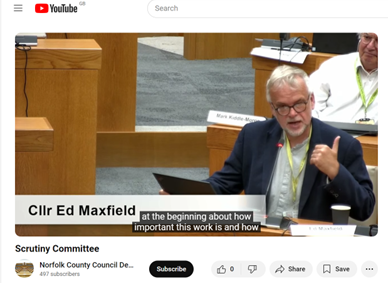Youth Justice and Neurodivergence
At the August meeting of the County Council’s Scrutiny Committee, we examined the Norfolk Youth Justice Strategy.
This is an important area of work and I suggested much more could be done to make information accessible and more widely seen. I also asked what the Council is doing to focus on those caught in the criminal justice system who have ADHD or similar conditions.
The County Council hosts the Norfolk Youth Justice Board, bringing together a range of different organisations to develop and deliver a strategy that aims to reduce offending and re-offending. I suspect very few people know about its work.
A number of councillors on the Scrutiny Committee made the point that the plan we were reviewing was thick with detail and not particularly easy to follow if you are not a specialist. It turns out that the format of the report – and the information reported on – is set centrally and the County Council has asked a number of times for this to be changed.
That’s true, but I also made the point that the County Council could do more itself to promote the work and increase engagement. In my contribution to the discussion I pointed out that there was nothing to tell me why I should care about the work – what the costs are of failure and the gains from getting it right. Most of Norfolk County Council’s website looks like it was designed in the 1980s but the Youth Justice Board webpages are particularly thin.
I also asked what was being done to focus on neurodiversity in the criminal justice system. From the few details we know, there appears to be a very high proportion of young people in the criminal justice system who live with conditions like ADHD. There is a need to collect more data. There is also a need to increase understanding of neurodiversity within the system itself. The real, pressing need though, is for there to be a wholesale change in the way society and institutions like schools view neurodiversity so that young people are not marginalised and placed at risk of exploitation because of a condition they live with.
You can read the report on the Scrutiny Committee papers here (page 20 onwards).
You can also watch the Scrutiny Committee here. The discussion of the Youth Justice report starts 15 minutes 26 second in. My contribution is at 33 minutes 13 seconds.
There is an excellent review of evidence into neurodiversity in the criminal justice system from the Criminal Justice Inspectorate available online if you are interested to learn more.

